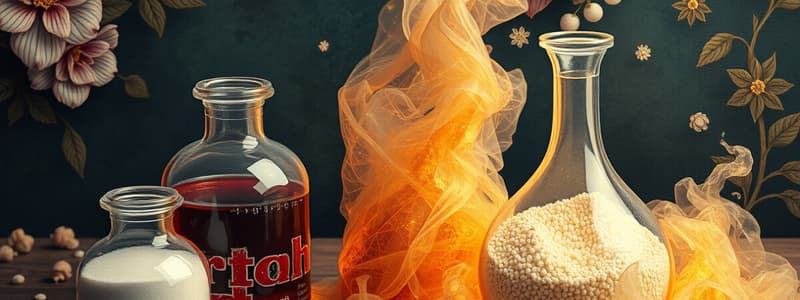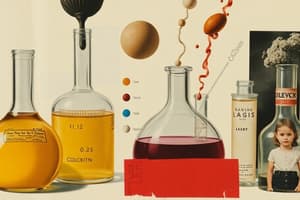Podcast
Questions and Answers
Differentiate between pure substances and mixtures.
Differentiate between pure substances and mixtures.
Pure substances are made of only one component with consistent physical and chemical properties, while mixtures consist of two or more substances that retain their own chemical identity.
Describe the special features of alloys. Give two examples.
Describe the special features of alloys. Give two examples.
Alloys are usually homogeneous mixtures or metallic solid solutions. Examples include stainless steel and bronze.
Explain how suspensions differ from colloids.
Explain how suspensions differ from colloids.
Suspensions contain larger solid particles that settle and require shaking, while colloids contain smaller particles that remain suspended.
List any two types of mixtures that are not covered in the Exploration. Also mention the state in which the constituents of these mixtures are.
List any two types of mixtures that are not covered in the Exploration. Also mention the state in which the constituents of these mixtures are.
Explain why water, sugar, and salt are classified as pure substances.
Explain why water, sugar, and salt are classified as pure substances.
Describe which liquids can be classified as solutions. List their characteristics.
Describe which liquids can be classified as solutions. List their characteristics.
Classify the following as either a homogeneous or heterogeneous mixture: vinegar, salt water, salad dressing.
Classify the following as either a homogeneous or heterogeneous mixture: vinegar, salt water, salad dressing.
Classify each of the items found on the kitchen counter: salad dressing, peanut butter, sugar syrup, stainless steel, water.
Classify each of the items found on the kitchen counter: salad dressing, peanut butter, sugar syrup, stainless steel, water.
Classify the following items into mixtures and pure substances: iron frying pan, glass, air, and whipped cream.
Classify the following items into mixtures and pure substances: iron frying pan, glass, air, and whipped cream.
Differentiate between homogeneous and heterogeneous mixtures.
Differentiate between homogeneous and heterogeneous mixtures.
Flashcards are hidden until you start studying
Study Notes
Classification of Matter
-
Pure Substances vs. Mixtures
- Matter can be classified into pure substances and mixtures.
- Pure substances consist of only one component with uniform physical and chemical properties.
- Pure substances can be further divided into elements and compounds.
- Mixtures contain two or more substances that retain their individual chemical identities.
-
Alloys
- Alloys are homogeneous mixtures or metallic solid solutions.
- Common examples include stainless steel (iron and chromium) and bronze (copper and tin).
-
Suspensions vs. Colloids
- Suspensions are mixtures with solid particles that can settle and require shaking before use (e.g., flour in water).
- Colloids contain smaller particles that remain evenly suspended (e.g., milk).
- Filters can separate components of suspensions but not colloids.
-
Examples of Mixtures
- Blood: A suspension containing nutrients, oxygen, and cells.
- Honey Mustard: A colloid made from water, mustard, sugar, honey, and other ingredients.
-
Classification of Water, Sugar, and Salt
- These substances are pure because they exhibit uniform composition and are classified as compounds.
-
Liquids Classified as Solutions
- Examples include vinegar and saltwater, where the solute completely dissolves in the solvent.
- Characteristics include containing more than one pure substance and uniform distribution.
-
Homogeneous vs. Heterogeneous Mixtures
- Homogeneous (uniform composition): Examples include vinegar and saltwater.
- Heterogeneous (non-uniform composition): Includes salad dressing.
-
Classification of Kitchen Items
- Salad Dressing: Suspension.
- Peanut Butter: Colloid.
- Sugar Syrup: Pure Substance.
- Stainless Steel: Alloy.
- Water: Pure Substance.
-
Mixtures vs. Pure Substances
- Iron Frying Pan: Pure Substance.
- Glass: Mixture (made of various pure substances).
- Air: Mixture (composed of various gases).
- Whipped Cream: Mixture (contains air and liquid).
-
Difference Between Homogeneous and Heterogeneous Mixtures
- Homogeneous mixtures have a consistent composition throughout.
- Heterogeneous mixtures exhibit varied composition and disorganized distribution of components.
Studying That Suits You
Use AI to generate personalized quizzes and flashcards to suit your learning preferences.




